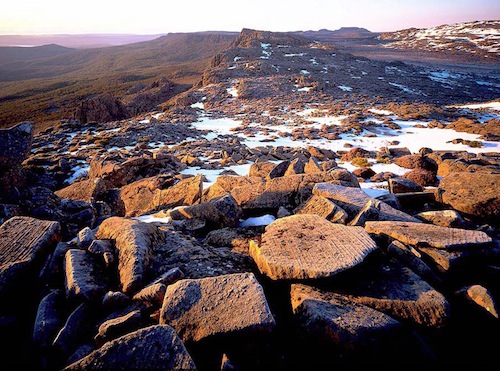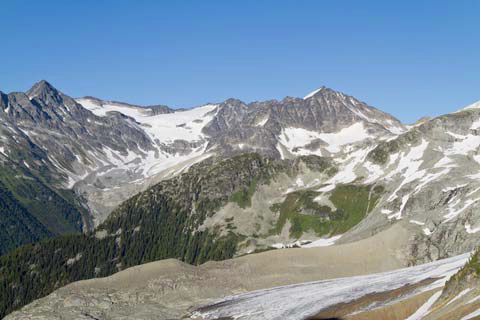Do you think we in Tasmania are far removed from the impact of climate change? Think again!

Ben Lomond’s rocky alpine area. PHOTO courtesy Rob Blakers
This is a story about human frailty, about Tasmania’s political failure to prioritise what is really important and — in the face of collective denial — it’s about the absurdity of trying to adapt to an ever worsening situation. But I’ve got to get there the long way around, so please bear with me.
-o-
The protracted, tortuous demise of the proposed Tamar Valley pulp mill has seen the Tasmanian press awash with a swag of angry commentary lately, much of it bemoaning the “green menace” that is supposedly destroying Tasmania. This type of emotive and hostile reaction was always inevitable and understandable. We need to be sensitive to the short term dislocation and pain that accompanies the restructuring of any industry that’s got itself into trouble, whether it be car manufacturing, gambling or forestry.
Against this backdrop it is all too easy to be caught up in the intemperate media frenzy and to lose focus on the much, much bigger picture. What diabolical menace is really threatening our prosperity and that of all future Tasmanians? How are we facing up to those monumental challenges? What fate awaits all of us if we choose turn a blind eye to them?
Foremost of these menaces is climate change. It’s real, it’s pernicious, it’s accelerating and it’s so mind bogglingly colossal that most people, including many “green” people, feel totally stonkered by it, unable to process the issue in their own heads. Denial runs rife. Not only denial of the raw facts, but even for those who accept the facts, denial in how well we respond… or don’t respond. So much easier for us — and more so for our governments — to focus on smaller things that our heads can cope with more easily. Those same shrill political voices that bemoan the gradual decline of forest jobs are strangely silent when it comes to the bigger fate that awaits all of us.
The climate change that most people are confronted by strikes with devastating consequences — ferocious hurricanes, forest fires and floods leave in their wake thousands of ruined lives and livelihoods. These all too frequent events are happening to “other unfortunate people” who we see on TV, and this tyranny of distance allows us a feeling of relative safety and complacency. The brick wall seems such a long way off. In Tasmania we’re pretty safe, aren’t we?
The truth is, in Tasmania we feel too safe and secure and we should not. Climate change is perniciously changing the face of Tasmania as I write this. Those who deal in botany, zoology, the earth sciences and marine science need no convincing. They are truly frightened by the pace of change that is taking place before their eyes, unable to adequately communicate the level of urgency that they honestly feel. There’s a reason for this. The body politic is not jolted into action unless there is an economic imperative at stake. As the saying goes: “It’s the economy, stupid!”
And even when the economy is clearly affected, more often than not there’s a blind refusal to connect the dots. It took Hydro Tasmania more than a decade to officially conclude that reduced inflows into their storages are likely to be permanent, calculating a whopping 10 percent loss of system power output. Ten percent may seem a fairly insignificant number, but it equates in size to the power output of the proposed Gordon Below Franklin dam that caused so much controversy thirty years ago. In modern day accounting terms, the water inflow losses from climate change equate to a loss of some $1 billion in the value of its assets.
We’ve also seen significant financial impacts on the otherwise profitable salmon farming industry, as a result of viral diseases, and the more recent closure of Tasmanian export shell fisheries as a result of algal bloom — those events being blamed an the record increase in sea temperatures off Tasmania’s East Coast, recorded as the fastest warming seas in the southern hemisphere.
The reason we don’t see angry, vituperative commentary in the press about these economic repercussions is because the culprit is not a politician or a corporation or a bunch of activists… it’s an abstract phrase called climate change. When the distance between “cause” and “effect” is so big and amorphous, who is there to blame or hate, other than the messenger?

World glaciers are disappearing fast; the issue in Tasmania is loss of winter
snow.
At this point I would like to join together another set of dots, the inexorable loss of Tasmania’s ski fields — yet another economic victim of climate change that the powers-that-be in Tasmania don’t seem keen to talk about. I’m no skier, but this is an exemplar story worth spelling out to skiers and non-skiers alike because it’s been going on for some time and the economic loss to Tasmania of this important facet of our recreation industry is already considerable. More so, this is a metaphorical window through which we can see the futility of trying to adapt when there’s no realistic chance of adapting.
We need to keep in mind that according to a federally funded scientific report, snow cover in the Australian alpine areas has declined by more than 30 per cent since 1954. As already mentioned, climate change is already impacting on Hydro Tasmania. Not only is it affected by increased evaporation from drier soils, its operations are also affected by the loss of snow cover that used to bedeck our magnificent mountain ranges, often for months on end, and so supply the Hydro with a bountiful Spring supply of water that its water storages could not contain all at once.
What does this loss of snow mean for our ski fields? Let’s first go back to the 1970s. Just like when our hair gradually turns grey there’s never a moment when we can say, “it happened in that instant!” When the ever so gradual loss of skiable snow started to become apparent in Tasmania it was thought we were just having a few bad winters. Disappointed ski enthusiasts at Mt Field began lobbying the Parks and Wildlife Service to extend the shrinking ski season by slope grooming. (“Slope grooming” is removal of rocks and vegetation so that a ski slope can be skiable even with a few centimetres of snow.)
Well, slope grooming is not welcomed by field naturalists because it can cause serious damage to the microhabitats of delicate alpine flora and fauna, but despite media controversy, slope grooming at Mt Field went ahead in the 1980s. For a while it worked in the general interests of the skiing fraternity, but now jump ahead another 25 years and we find the ski tows at Mt Field lying idle through much of Winter as lack of snow has shortened the skiing season ever more.

An increasingly common snow report for Ben Lomond
What wasn’t mentioned back then, but is evident now, is that climate change is the almost-certain cause. But much worse is to come. The same scientific study cited above has warned that Australia’s alpine areas are likely to receive no consolidated bed of Winter snow at all by the year 2050… that is, if climate change continues unabated. Keep in mind that Tasmania has only one commercial ski field, Ben Lomond, and this is accepted as the most marginal ski field in the nation. It too, year by year, is suffering from unreliable snow.
What is at risk now is the total loss of any commercial snow field in Tasmania because our famed mountains, though spectacular, are some 300 metres lower than the ski fields in Victoria that receive much more reliable snow every Winter. And what does that mean economically for Tasmania? Apart from the potential loss of that business, and the loss of this recreational opportunity for all Tasmanians, the major economic fallout is that hundreds of Tasmanian ski enthusiasts now just hop onto planes and fly off to Victoria and New Zealand for their winter experience, taking their dollars with them.
During the 1990s, a general lessening of skiable snow at Ben Lomond saw intense lobbying of state government to allow for (and help fund) slope grooming at Ben Lomond. The commercial operation there is becoming critically marginal, and so various plans have been drawn up and haggled over for some ten years to try to make the Ben Lomond ski field viable under worsening conditions. Wary of potential ecological damage to the mountain, Parks and Wildlife have been slow to respond, but now the management plan for the area allows for managed slope grooming, albeit with no public purse to make it happen. As the commercial operator is unable to fork out the cost of doing that work, volunteer teams were organised in 2012 to undertake controlled slope grooming — full credit to the skiing community’s enthusiasm.
Well, that would be nice if that’s where the story ended. Now let’s look at the next decade or two. There’s still a reluctance to connect the dots, so I will spell out what the commercial operators are reluctant to:
- Accept that climate change will eventually result in virtually no skiable natural snow in Tasmanian mountain ski areas. Not even on groomed slopes. And that time may be sooner than we think.
Desperate to keep their dream alive, commercial operators are now entertaining the idea of manufacturing artificial snow at Ben Lomond. The word “desperate” is totally appropriate because manufacturing snow is a very costly business and would add costs to what is already the most marginal ski mountain in Australia, doubling ski-tow ticket prices. That’s if manufacturing snow in Tasmania’s humid conditions proves viable.
I feel for all those good ski enthusiasts who are seeing their recreational asset slowly shrivel up, and also for the plight of those in the business who don’t wish to see it all collapse in a heap. This story is a poignant reminder to us all that climate change is already having manifest repercussions in society as a whole, including our well-being and general prosperity. The pace of that change is accelerating by the day.
The slope grooming saga is an opportune window whereby we can catch a glimpse of the future, because climate change is having its most acute impact right now at that crucial interface, our mountain snow lines. According to research, the snow line of Australia’s mountains is moving upwards at the rate of some 6 metres or more per year. Sad to say, Tasmania’s mountains aren’t tall enough to sustain skiable snow for very much longer.
This saga also gives us valuable insights into government and public attitudes to climate mitigation (reducing emissions) versus adaptation trying to cope). There’s a prevailing tendency in government bureaucracy to think of climate change as inevitable, so let’s drop our bundle and learn to live with it. Thrive even. Coping with the impacts of climate change is something that we have no choice but to do and governments have a legitimate role there, but a disturbingly complacent narrative seems to be gripping the mind of state government of late, that by adapting to change we’ll get along just fine. The hard nosed reality is that our civilisation faces total system breakdown if governments head down that track.
As one savvy commentator pointed out some time ago: “There are only three responses to climate change, there is 1) mitigation, there is 2) adaptation and there is 3) suffering.”
The slope grooming issue may seem somewhat trifling in the scheme of things but it gives us a timely canary-in-the-coal-mines set of warnings: that there is a strict limit to adaptation; that it is impossible and futile to try to adapt to catastrophic climate change; that as much as we deny reality, the primary focus of governments at all levels, big and small, is do whatever it takes to reduce greenhouse emissions as our number one priority.
Is it true that no two snowflakes are the same?
A typical small snow crystal might contain 1018 (that’s 10 million million million) water molecules. About one in a thousand (1015) of these molecules will be different from the others, in the form of heavy water. These unusual molecule combinations will be randomly scattered throughout the snow crystal, giving it a unique design. The probability that two snow crystals would have exactly the same layout of these different molecules is very, very, very small. So small that the odds of it happening within the lifetime of the Universe is indistinguishable from zero.
* Chris Harries is a member of the Tasmanian Climate Action Council.
References

